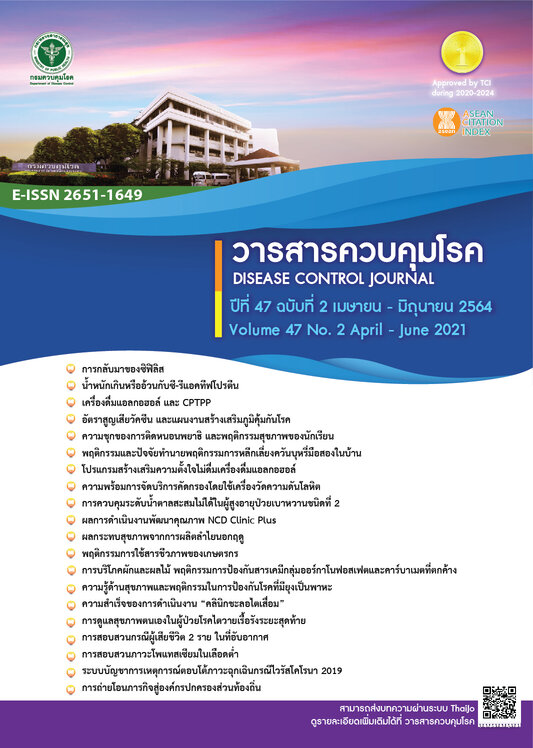Impact of vaccine wastage rate on national vaccine management and immunization schedule: A case study of DTP, DTP-HB and DTP-HB-Hib vaccine
DOI:
https://doi.org/10.14456/dcj.2021.21Keywords:
vaccine wastage, vaccine management, DTP; DTP-HB; DTP-HB-HibAbstract
Vaccine is a crucial tool in public health intervention to prevent and protect against the vaccine preventable diseases (VPDs). An efficient vaccine management should be considered based on cost-benefit assessments for the general population. The vaccine wastage is a key factor to manage and balance between cost and benefit for the national immunization program (also known as the EPI program). The objective of this study is to determine the ways and factors that can reduce a wastage rate on the EPI program. A descriptive cross-sectional study was conducted by multi-stage simple random sampling on participating health facilities at all levels. A total of 242 health facilities were selected from 12 districts of 12 sampling provinces. A total of 2,945 vaccine request forms (V.3/1) were analyzed. A mean vaccine wastage rate of DTP-HB and DTP was 36.07 and 45.19, respectively. The wastage rate was higher than expected national target, i.e. not greater than 25% for 10 doses/vial of vaccine package. It was found that 18.7% of wastage rate was caused by less than five children coming to receive the vaccine, and 49.4% of wastage rate was due to less than 10 children visit a health facility for vaccination. Based on the findings, a lower number of children is the main cause of high vaccine wastage rate that appeared to be unavoidable. When the size of vaccine package had been changed to 5 and 2 doses/vial, the wastage rate was reduced to 18.03% and 6.12%, respectively. On the other hand, to increase a dose or doses of vaccine for the immunization schedule to 4 and 5 doses of DTP-HB, wastage rate was found to have decreased to 25.96% and 20.75%, respectively. At present, the EPI program has replaced DTP-HB with DTP-HB-Hib to prevent meningitis and pneumonitis from Hib. Conclusion: For an effective vaccine management to reduce the vaccine wastage rate and improve a cost-benefit ratio to prevent the diseases, the national immunization schedule should implement a change in DTP-HB-Hib package from 3 doses to 4 or 5 doses or, alternatively, replace DTP vaccine with DTP-HB-Hib as a single formular vaccine. This change will need an additional budget of approximately 7-13 million Baht/year, representing 0.87-1.0% of total budget, for a new immunization schedule to increase immunity and improve service delivery and safety for the EPI program.
Downloads
References
World Health Organization. Effective Vaccine Management (EVM) Initiative, Department of Vaccines and Biological [Internet]. [cited 2019 Sep 9]. Available from: https://www.who.int/immunization/programmes_systems/supply_chain/EVM-JS_final.pdf
Duttagupta C, Bhattacharyya D, Narayanan P, Pattanshetty SM. Vaccine wastage at level of service delivery: across-sectional study. Public Health. 2017;148:63-5.
Aaron SW, Fred W, Eric N, Boubacar D, Naawa S, Tove KR, et al. Vaccine wastage in Nigeria: An assessment of wastage rates and related vaccinator knowledge, attitudes and practices. Vaccine. 2017;35:6751-8.
Patrick TW, Elizabeth AM, Leila AH, Wendy P, Shawn TB, Kirstin K, et al. The value of tailoring vial sizes to populations and locations. Vaccine. 2019;37:637-44.
Parmar D, Baruwa EM, Zuber P, Kone S; Impact of wastage on single and multi-dose vaccine vials: implications for introducing pneumococcal vaccines in developing countries. Hum Vaccines. 2010;6:270-8.
Division of Vaccine Preventable Disease, Department of Disease Control; Immunization Schedule 2018. [Internet]. [cited 2017 Dec 1]. Available from: http://dvpd.ddc.moph.go.th/content/download/105 (in Thai).
Chotpitayasunondh T. Bacterial meningitis in children: etiology and clinical features, an 11-year review of 618 cases. Southeast Asian J Trop Med Public Health. 1994;25:107-15.
Supachai R, Sophie CT, Supamit C, Charung M, Damien J, Alan B, et al. Prospective population-based incidence of Haemophilus influenzae type b meningitis in Thailand. Vaccine. 2004;22:975-83.
Sonja JO, Surang D, Leelawadee S, Supamit C, Scott FD. Frequent Haemophilus Influenza Type B Colonization in Rural Thailand. The Pediatric infectious Disease Journal. 2005;24:739-41.
Division of Vaccine Preventable Disease, Department of Disease Control; Vaccine and Immunization 2019. Nonthaburi: Division of Vaccine Preventable Disease; 2019. (In Thai)
World Health Organization. Monitoring vaccine wastage at country level: Guideline for Program Managers. Department of Vaccines and Biological, World Health Organization. WHO Document, WHO/V&B/03.18/Rev.1;2005
World Health Organization. WHO Policy Statement: Multi-dose Vial Policy (MDVP) Revision 2014; Handling of multi-dose vaccine vials after opening. Department of Vaccines and Biological, World Health Organization. WHO Document, WHO/IVB/14.07;2014.
Stephane G, Karen H, Brint B, Serguei D, Christine N, Selina AM, et al. Vaccine wastage in Bangladesh. Vaccine. 2010;28:858-63.
Sirirat T, Pornsak Y, Porpit V, Aimorn R; Wastage of Multi-dose Measles Vaccine Survey in Public Health Facilities. Disease Control Journal. 2008;34(3):311-26. (in Thai)
Aaron SW, Kong K, John H, Eleanor B, Nari C, Richard D, et al; Assessment of vaccine wastage rates, missed opportunities and related knowledge, attitudes and practices during introduction of a second dose of measles-containing vaccine into Cambodia’s national immunization program. Vaccine. 2018;36:4517-24.
Palanivel C, Vaman K, Kalaiselvi S, Baridalyne N. Vaccine wastage assessment in primary care setting in urban India. Journal of Pediatric Sciences. 2012;4:e119.
Posuwan N, Wanlapakorn N, Vongpunsawad S, Sintusek P, Leuridan E, Poovorawan Y, et al. Comparison of hepatits b surface antibody levels induced by the pentavalent DTwP-HB-Hib versus the hexavalent DTaP-HB-Hib-IPV vaccine, administered to infans at 2, 4, 6, and 18 months of age, following monovalent hepatitis b vaccination at birth. Vaccine. 2020;38:1643-51
Downloads
Published
How to Cite
Issue
Section
License
Articles published in the Disease Control Journal are considered as academic work, research or analysis of the personal opinion of the authors, not the opinion of the Thailand Department of Disease Control or editorial team. The authors must be responsible for their articles.






